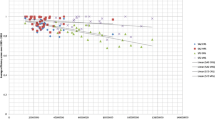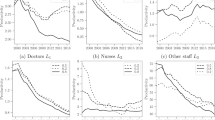Abstract
Hospital productivity has been a research topic for over two decades. Whereas much has been learned regarding cost, technical, scale, and allocative efficiency as well as the impact that weakly disposable inputs/outputs have on hospital behavior, we expand on this research by examining size and service offering, or focus, efficiency at the metropolitan area level for US hospitals. By using an extension of the Free Coordination Hull (FCH), we are able to determine whether hospitals in our sample could become more efficient if they provided more services (reduce inefficiency due to too narrow a focus) or fewer services (reduce inefficiency due to too broad a focus). Our results suggest that findings vary among the hospital markets. This approach could be used by policy makers and managers in order to reduce costs by sharing services, reducing services in hospitals, or expanding services in hospitals. Findings from a study such as this should aid reform programs by providing more information on the sources of hospital inefficiency.
Similar content being viewed by others
Notes
We do not examine the issue of specialty hospitals vs. general hospitals. Specialty hospitals serve specific patient populations (e.g., children) or provide a limited type of care (e.g., orthopedic); general hospitals serve broad populations and offer a wide range of services. The increased presence of specialty hospitals has been controversial. Proponents of specialty hospitals argue that their focus can lead to lower costs and higher quality; opponents contend that they cream-skim healthier patients and more profitable services away from general hospitals. See, for example, Barro et al. (2006) for a discussion of this issue.
Greater specialization among hospitals would increase each hospital’s volume of its specific output, which would increase capacity utilization and, potentially, quality (Kraus et al. 2005).
Earlier studies have proposed ways to measure economies of scope using the nonparametric method DEA (e.g., Ferrier et al. 1993 and Morita 2003); unfortunately, DEA imposes convexity on the reference technology. The drawback of convexity is that there can be no measure of efficiency improvements by specialization gains because, by construction, the convex combination of two or more production plans is always on or below the efficient frontier.
A new definition of the metropolitan areas, the Core Based Statistical Area, or CBSA, replaced the Metropolitan Statistical Area (MSA), after the 2000 U.S. Census.
We focus only on the hospital side of an observation’s operations rather than including both the hospital and the nursing home components that may operate within the same hospital.
References
Bamezai, A., Zwanziger, J., Melnick, G. A., & Mann, J. M. (1999). Price competition and hospital cost growth in the United States (1989–1994). Health Economics, 8(3), 233–243.
Banker, R. D., Charnes, A., & Cooper, W. W. (1984). Some models for estimating technical and scale inefficiencies in data envelopment analysis. Management Science, 30(9), 1078–1092.
Banker, R. D., Conrad, R. F., & Strauss, R. P. (1986). A comparative application of data envelopment analysis and translog methods: an illustrative study of hospital production. Management Science, 32(1), 30–44.
Barro, J. R., Huckman, R. S., & Kessler, D. P. (2006). The effects of cardiac specialty hospitals on the cost and quality of medical care. Journal of Health Economics, 25(2006), 702–721.
Baumol, W. J. (1993). Health care, education and the cost disease: A looming crisis for public choice. In C. K. Rowley, F. Schneider, & R. D. Tollison (Eds.), The next twenty-five years of public choice (pp. 17–28). Netherlands: Springer.
Brown, M. L., Kessler, L. G., & Rueter, F. G. (1990). Is the supply of mammography machines outstripping need and demand? An economic analysis. Annals of Internal Medicine, 113(7), 547–552.
Centers for Medicare and Medicaid Services (2012). National health expenditures 2011 highlights. http://www.cms.gov/Research-Statistics-Data-and-Systems/Statistics-Trends-and-Reports/NationalHealthExpendData/Downloads/highlights.pdf. Accessed 15 May 2013.
Chilingerian, J. A., & Sherman, H. D. (2011). Health-care applications: From hospitals to physicians, from productive efficiency to quality frontiers. In W. W. Cooper et al. (Eds.), Handbook on data envelopment analysis (pp. 445–493). New York: Springer Science+Business Media, LLC.
Cutler, D. M. (2000). The changing hospital industry: Comparing not-for-profit and for-profit institutions. Chicago: University of Chicago Press.
David, G., Helmchen, L. A., & Henderson, R. A. (2009). Does advanced medical technology encourage hospitalist use and their direct employment by hospitals? Health Economics, 18(2), 237–247.
Deprins, D., Simar, L., & Tulkens, H. (1984). Measuring labor-efficiency in post offices. In M. Marchand, P. Pestieau, & H. Tulkens (Eds.), The performance of public enterprises: Concepts and measurement (pp. 243–267). Amsterdam: Elsevier Science Publishing.
Devers, K. J., Brewster, L. R., & Casalino, L. P. (2003). Changes in hospital competitive strategy: a new medical arms race? Health Services Research, 38(1, part II), 447–469.
Farrell, M. J. (1957). The measurement of productive efficiency. Journal of the Royal Statistical Society Series A (General), 120(3), 253–290.
Ferrier, G. D., Grosskopf, S., Hayes, K., & Yaisawarng, S. (1993). Economics of diversification in the banking industry: a frontier approach. Journal of Monetary Economics, 31(2), 229–249.
Fournier, G. M., & Mitchell, J. M. (1992). Hospital costs and competition for services: a multiproduct analysis. The Review of Economics and Statistics 74(4), 627–634.
Green, R. H., & Cook, W. D. (2004). A free coordination hull approach to efficiency measurement. Journal of the Operational Research Society, 55(10), 1059–1063.
Günes, E. D., Chick, S. E., & Zeynep Akşin, O. (2004). Breast cancer screening: trade-offs in quality, capacity, outreach, and centralization. Health Care Management Science, 7(4), 291–303.
Heckler, M. (1984). Foreword. In J. M. Virgo (Ed.), Health care: An international perspective (pp. ix–x). St. Louis: International Health Economics and Management Institute.
Hollingsworth, B. (2003). Non-parametric and parametric applications measuring efficiency in health care. Health Care Management Science, 6(4), 203–218.
Hollingsworth, B. (2008). The measurement of efficiency and productivity in health care delivery. Health Economics, 17(10), 1107–1128.
Hollingsworth, B., Dawson, P. J., & Maniadakis, N. (1999). Efficiency measurement of health care: a review of non–parametric methods and applications. Health Care Management Science, 2(3), 161–172.
Kessler, D. P., & McClellan, M. B. (2000). Is hospital competition socially wasteful? Quarterly Journal of Economics, 115(2), 577–615.
Kittelsen, S., & Magnussen, J. (2003). Economies of Scope in Norwegian Hospital Production—A DEA Approach. University of Oslo, Health Economics Research Program Working Paper 2003:8.
Kraus, T. W., Büchler, M., & Herfarth, C. (2005). Relationships between volume, efficiency, and quality in surgery—a delicate balance from managerial perspectives. World Journal of Surgery, 29(10), 1234–1240.
Lee, K., Chun, K., & Lee, J. (2008). Reforming the hospital service structure to improve efficiency: urban hospital specialization. Health Policy, 87(1), 41–49.
Lichtenberg, F. (2003). Does hospital productivity grow at the same rate as productivity in the rest of the economy? http://www.aha.org/aha/content/2004/pdf/040106-attach-lichtenberg.pdf. Accessed 15 May 2013.
Maindiratta, A. (1990). Largest size-efficient scale and size efficiencies of decision making units in data envelopment analysis. Journal of Econometrics, 46(1/2), 57–72.
Morita, H. (2003). An analysis of economies of scope by data envelopment analysis: comparison of efficient frontiers. International Transactions in Operational Research, 10(4), 393–402.
Panzar, J. C., & Willig, R. D. (1981). Economies of scope. American Economic Review, 71(2), 268–272.
Pauly, M. V. (1980). Doctors and their workshops: Economic models of physician behavior. Chicago: University of Chicago Press.
Preyra, C., & Pink, G. (2006). Scale and scope economies through hospital consolidations. Journal of Health Economics, 25(6), 1049–1068.
Prior, D., & Solà, M. (2000). Technical efficiency and economies of diversification in health care. Health Care Management Science, 3(4), 299–307.
Santerre, R. E., & Neun, S. P. (2009). Health economics: Theories, insights, and industry studies (5th ed.). Mason: South-Western Cengage Learning.
Santerre, R. E., & Pepper, D. (2000). Survivorship in the US hospital services industry. Managerial and Decision Economics, 21(5), 181–189.
Scarf, H. E. (1986). Testing for optimality in the absence of convexity. In W. P. Heller, R. M. Starr, & S. A. Starrett (Eds.), Social choice and public decision making: Essays in honor of Kenneth J. Arrow, Volume I (pp. 117–134). Cambridge: Cambridge University Press.
Shain, M., & Roemer, M. I. (1959). Hospital costs relate to the supply of bed. Modern Hospital, 9(4), 71–73.
Shepherd, R. W. (1953). Cost and production functions. Princeton: Princeton University Press.
Shepherd, R. W. (1970). Theory of cost and production functions. Princeton: Princeton University Press.
Thomas, L. (1971). The technology of medicine. New England Journal of Medicine, 285(24), 1366–1368.
Virgo, J. M. (1984a). Health care: An international perspective. St. Louis: International Health Economics and Management Institute.
Virgo, J. M. (1984b). The changing health care sector. In J. M. Virgo (Ed.), Health care: An international perspective (pp. 3–14). St. Louis: International Health Economics and Management Institute.
Virgo, J. M. (1985). Restructuring of the health care system. In J. M. Virgo (Ed.), Exploring new vistas in health care (pp. 1–11). St. Louis: International Health Economics and Management Institute.
Worthington, A. C. (2004). Frontier efficiency measurement in healthcare: a review of empirical techniques and selected applications. Medical Care Research and Review, 61(2), 1–36.
Author information
Authors and Affiliations
Corresponding author
Appendix
Appendix
Rights and permissions
About this article
Cite this article
Ferrier, G.D., Leleu, H., Moises, J. et al. The Focus Efficiency of U.S. Hospitals. Atl Econ J 41, 241–263 (2013). https://doi.org/10.1007/s11293-013-9385-z
Published:
Issue Date:
DOI: https://doi.org/10.1007/s11293-013-9385-z




